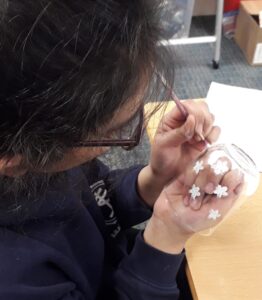Arts Week 2022
St Stephens have just had our annual ‘Arts Week’. This is a wonderful opportunity for us to explore a particular artist and all the brilliant work that they have done. This year the artist was Fahrelnissa Zeid who was a Turkish princess who sadly has not received the recognition that she should have for her incredible works of art and the part she played in the art world in the 1900s. She is most famous for her enormous, kaleidoscopic abstract expressionist paintings and her stylised portraits.
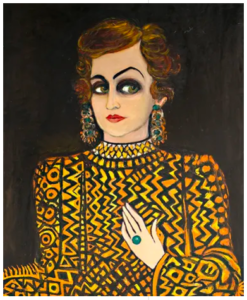
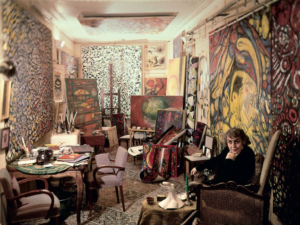
Nursery
The children in Nursery had a great week learning all about colours. We learnt how to mix primary colours into secondary ones and made beautiful paintings the new colours we created. We looked at the work of Fahrelnissa Zeid and made self portraits based on her work.
Reception
In Reception the children have been inspired by the Blue Mosque in Turkey, the birth place of Fahrelnissa Zeid. They looked closely at photos of the mosque and identified the different shapes they could see. They then used different collage techniques to create pictures of mosques. They tore different coloured paper from magazines and they also drew around 2D shapes and arranged them carefully to form mosque like shapes. Inspired by the beautiful blue and white tiles often found in countries where there are large Muslim communities, the children used potatoes with different shapes cut out of them to print their own tiles. They also enjoyed using masking tape to create abstract shapes on their paper and painted these different shapes with bold paints before carefully removing the masking tape to recreate some of Zeid’s large scale abstract paintings. Finally the children decorated moons and stars with paint and sponges and embellished them by wrapping rainbow wool around them.
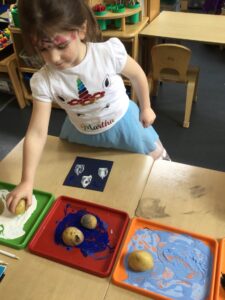
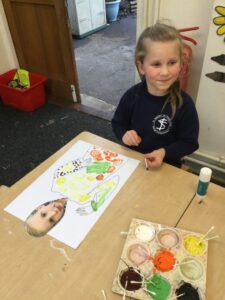
Year 1
Using the vibrant work of Fahrelnissa Zeid as inspiration, Year 1 have created eye-catching mosques out of coloured card and stained glass windows using tissue and tracing paper. They also focused on Zeid’s statement fashion and jewellery choices, designing their own clothes out of bits of textured paper and making chunky beaded bracelets and necklaces. Finally, they were tasked with designing their own Islamic tiles, thinking about symmetry and worked as a team to put together large A3 collages made up of different shapes.
Year 2
Fahrelnissa Zeid felt very sad at some points during her life. She used painting and art to help her express these sad feelings. The year 2s then created their own work using line and colour to reflect certain emotions.
We were lucky enough to have two artists come in to teach us about figure and portrait painting – some realistic, some much less so! The children used mixed media to create portraits in one session and worked as a team to make a whole body in the other.
In our Arts Week Spanish lesson we read ‘El Monstruo de Colores’ (The Colour Monster). We decided which Spanish emotion belonged with which Spanish colour. We then created our own monsters about our feelings with googly eyes on lollypop sticks.
After learning all about Fahrelnissa Zeid and her colourful life which spanned many different cultures and experiences, the children coloured in all the very many places which influenced her and her art on a world map. The children then used a different colour to colour in any countries that inspire them, either that they have family in or that are important to them.
Next, we spent some time looking at Fahrelnissa’s kaleidoscopic artwork. The children then created a collage taking inspiration from these works and a black and white photo of Zeid and her family. We practised writing ‘Zeid’ in the Arabic (one of her languages) and added this to the mix.
The children then had a go at making clay pots and decorating them with some of the
Islamic patterns that inspired Zeid.
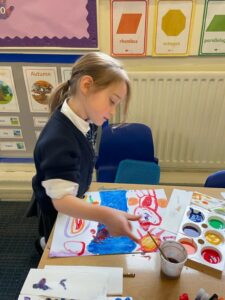
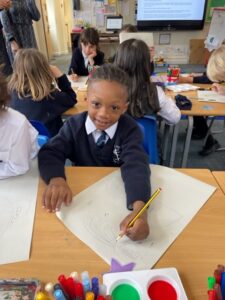
Year 3
Zeid was a practising Muslim and took a lot of inspiration from her faith. The children in Year 3 did a collage activity which was inspired by some of the beautiful mosques. The children chose some vibrant colours to create beautiful patterns on a mosque of their choice. Some children went for abstract patterns while other children focused on symmetry.
The children also did some portrait work with an artist (Marlow’s mum)! Other activities in Year 3 included squiggly abstract pattern pieces, abstract body art and stained glass windows (making good use of translucent – there’s a Science term taught last half term! – coloured tissue paper!)
Mr Faith also did some art teaching, explaining the concept of pointillism, which children experimented with, tricking the eye into seeing a range of colours. We also explored the concept of symmetry, and how judicious use of it can result in appealing pieces of work.
In our Arts Week Spanish lesson we read ‘El Monstruo de Colores’ (The Colour Monster). We decided which Spanish emotion belonged with which Spanish colour. We then created our own monsters about our feelings with googly eyes on lollypop sticks.
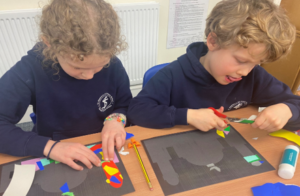
Year 4
The children in Year 4 started Arts Weeks by looking at the tales of the Arabian Nights – a book steeped in the Middle and Far East cultures and a popular muse for the artist. The children had a choice of one of a tale such as Aladdin or Sinbad and recreated the story as a storyboard/cartoon.
The children also made mosaics using a pattern and then using PVC glue to stick assorted dried food items in the shapes on the page. The food items included pasta, lentils, rice, peas, beans and other varieties.
The children then dine some line drawings which they added colour to. As the lines crossed each other the lines created windows or shapes and we were part was to be coloured in similar bright and vivid colours like Elsa’s picture. We also wanted to see if we could create a shape or figure within.
Zeid was inspired by the colours that she saw through latticed windows. The children recreated colourful stained glass windows. Instead of using paint or colouring pencils we cut out the frames of a window and then filled in each section using brightly coloured tissues.
As a practising Muslim, many of the themes of Fahlrelnissa Zeid’s work have an Islamic theme. we acknowledged Zeid’s Islamic faith by drawing and painting a mosque in a colourful setting. Using a variety of skills we used oil paints to create a setting of the background and then drew the silhouette of a Mosque before painting it in black.
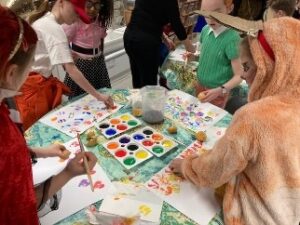
Year 5
In Year 5 we spent the week exploring Zeid’s use of colour and line and I think it is fair to say that our pupils (across the school) have been inspired by Zeid’s pieces. We created our own take on ‘Break of the Atom and Vegetal Life’ with children making their own abstract shapes before colouring them in contrasting colours to create a mind bending effect. We were then inspired by Zeid’s portraits and using black and white photography we altered our own school uniforms using a collage of colourful paper and again abstract shapes with defined lines overall creating a wonderful pattern. After we had done this, we made our own kaleidoscopes inspired by Zeid’s patterns and use of vibrant, dramatic colour and pattern. We finished the week with children creating their own free verse poetry and paint spray pieces reflecting their emotions on that day and an tea party inspired by some of the places Zeid had lived: France, Iraq, Jordan and Turkey. Miss Assadi taught us some Iraqi games and we munched on Kleicha, Loomi Tea, dates and brie as a nod to wonderful cultures that Zeid celebrated in her work.
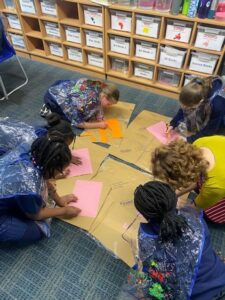
Year 6
Inspired by Fahrelnissa Zeid’s large-scale abstract paintings with kaleidoscopic patterns, the children began Arts Week with an abstract ‘scribble’ drawing. The children drew a scribble over a piece of paper which they then had to colour in following only one rule: try and not to put the same colour next to itself.
Next up was a self-portrait influenced by Zeid’s love for bright colours and intricate textures, the children were tasked with collaging a monotone photo of themselves using an array of paper, magazine and tissue paper to recreate their version of Zeid’s self- portrait. 6A transformed the dark colours of their school uniform into a collection of vibrant Islamic style fashion, whereas 6Z transformed the dark backgrounds into bright colours.
Year 6 also learnt all about Islamic art and how it features stylised motifs, interlacing patterns (such as geometric designs or arabesques) or calligraphy – or a combination. With this in mind the children revived and developed their recent learning about printing. They used a polystyrene square and a blunt pencil to carve their own symmetrical design to create a block for printing. They loaded the carved surface with paint using a roller and then pressed the block down carefully onto the sheet, exerting even pressure to ensure full contact and a good print. They repeated this four times to build up a mosaic patterned tapestry. Finally, the children learnt all about Arabic calligraphy and used this to scribe their Arabic name onto the tapestry.
